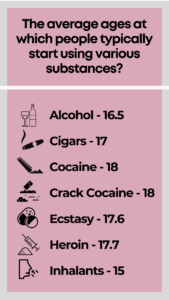When do most people start using drugs or drinking? It’s a question researchers continue to explore as the use of illicit substances grows across the country. The recent rise in drug related overdose deaths is not all attributable to the opioid crisis. One trend is clear. The younger someone starts experimenting or trying substances like alcohol or drugs, the more at risk they are for developing a substance use disorder.
The most recent data on drug use and age suggests today’s teens may be starting substance abuse later than teens in the previous decade. For decades we’ve seen adolescents start using various drugs and alcohol at younger and younger ages, but this trend appears to be shifting. A critical facet of curtailing substance abuse trends starts with monitoring and disrupting those trends at their roots.
What’s the Average Age People Start Using Drugs?
Most people start using drugs between the ages of 18 an 25, according to new data from the Substance Abuse and Mental Health Services Administration’s “2021 National Survey on Drug Use and Health.” The majority of Americans who use substances started using before the age of 21. An interesting finding is that 25% of people who started smoking marijuana in 2021 were aged 26 or older. Nearly 60% of people who used cocaine for the first time were 18 to 25. Americans between the ages of 18 and 25 are also more likely to start using heroin and methamphetamine than those in other age brackets.
people who used cocaine for the first time were 18 to 25. Americans between the ages of 18 and 25 are also more likely to start using heroin and methamphetamine than those in other age brackets.
The American Academy of Child & Adolescent Psychiatry (AACAP) reports increases in substance use by adolescents. Teenagers are the group to focus on. AACAP research indicates that the average age at which teens start using cannabis is 14. Teenage consumption of alcohol starts around age 12.
Marijuana and alcohol are two of the most common substances abused in high school per the AACAP. However, they report a broad spectrum of other drugs also commonly abused by high schoolers. Those include certain stimulants, prescription drugs, heroin and ecstasy. Here’s a look at the drugs most often used by teenagers.
Top 10 drugs abused by teens after alcohol:
- Marijuana
- Cocaine (or crack)
- Speed
- LSD
- PCP
- Opioid pain killers (or opiates)
- Heroin
- Ecstasy
- Ritalin
- Adderall
Development and Further Abuses
The initiation of substance use during childhood or adolescence correlates with major long-term health risks. This applies to both physical and behavioral health complications incurred down the road. Many studies agree, according to the 2014 Treatment Episode Data Set (TEDS) report from the Substance Abuse and Mental Health Services Administration.
The prevailing consensus among published research to date finds that the most consistent outcome of early substance abuse is the development of substance use disorders. This is commonly considered to be an outcome that comes much later in life, but the data suggests very little time passes for many kids.
“In fact, among adolescents, the transition from initiation to regular use of alcohol, marijuana, and other drugs often occurs within 3 years,” the TEDS report found.
High School Students Start Using Drugs, Drinking
 The Hazelden Betty Ford Foundation reported the same conclusions in 2015. They found children to be at significantly high risk for trying marijuana beginning around ages 13 and 14. They found comparable risk factors for those kids transitioning to crack or cocaine around ages 15 and 16. Their assessment for the earliest onset of alcohol abuse was pegged to ages 10 and 11.
The Hazelden Betty Ford Foundation reported the same conclusions in 2015. They found children to be at significantly high risk for trying marijuana beginning around ages 13 and 14. They found comparable risk factors for those kids transitioning to crack or cocaine around ages 15 and 16. Their assessment for the earliest onset of alcohol abuse was pegged to ages 10 and 11.
Age 16 is widely considered a target year for parents to hurdle with kids according to the Hazelden Betty Ford Foundation. Outcomes seem to swing in a more positive direction for those kids who make it beyond age 16 without indulging in substance abuse.
This includes drinking alcohol. Even casually drinking counts as abuse for those age 16 and under as reflected in federal law. However, those who first start drinking after age 16 aren’t necessarily at inordinate risk for developing alcohol use disorder.
Positive Trends in Initiation Age
A study published in JAMA Pediatrics as of March 2020 found the average age of teen substance abuse initiation to be rising. While the spectrum ranges from age 12 to age 21, the average has increased a full year from age 16 in 2004 to age 17 as of 2017. This was demonstrated to be the case in aggregate across 18 different drugs. Those drugs even included not only alcohol but also tobacco. The study analyzed changes in the average age of initiation from 2004 to 2017.
“This is great news because delaying drug use prevents early exposure, which is associated with a variety of negative health consequences,” said lead author Karl Alcover, “including increased risk of drug use disorder and long-term impairments such as depression, neurocognitive deficits, involvement in risky behaviors, and sexually transmitted diseases.”
Dr. Alcover is a postdoctoral research associate at Washington State University’s Elson S. Floyd College of Medicine. The study reviewed data collected as part of the National Survey on Drug Use and Health. The annual survey looks at drug use in a representative sample of American citizens of age 12 and older.
Key Takeaways in Age-Related Drug Use
Delaying the age at which your child engages in any type of substance use is critical. You can’t control their every action, but you can take the requisite steps if you suspect or discover that they’re drinking excessively or abusing other drugs.
It’s more important now than ever for parents to make sure that their kids don’t experiment with drugs. Many of the substances they’re likely to find and use are more potent than they used to be. This is because they’ve been re-engineered to be stronger.
That’s the case with synthetic cannabinoids like K-2 — the types of pot your child or loved one would most likely encounter. It’s also the case with synthetic opioids. Addiction experts and legal authorities regularly agree that these are among the most detrimental substances to our society today.
If you have a loved one struggling with substance abuse, Landmark Recovery can help by providing specialized addiction treatment and facilitating detox in the care of medical professionals. Call our addiction specialists today at 888.448.0302.

Choose Recovery Over Addiction
We're here 24/7 to help you get the care you need to live life on your terms, without drugs or alcohol. Talk to our recovery specialists today and learn about our integrated treatment programs.




